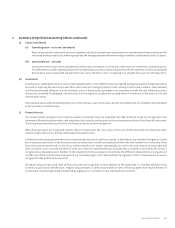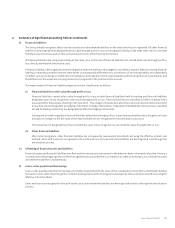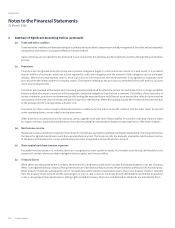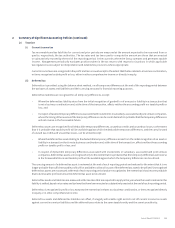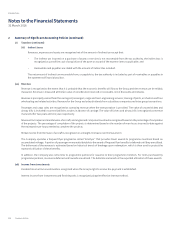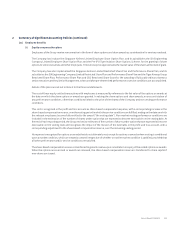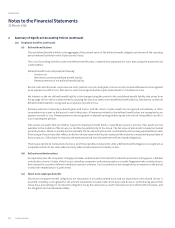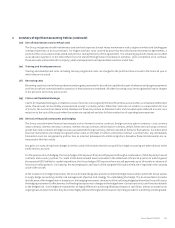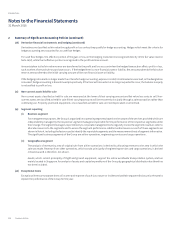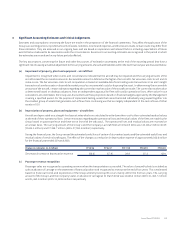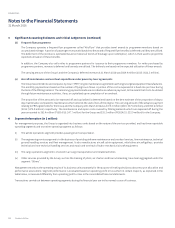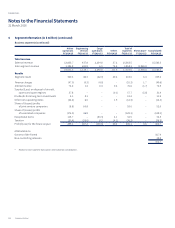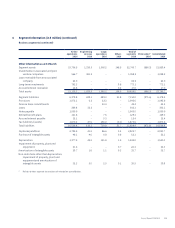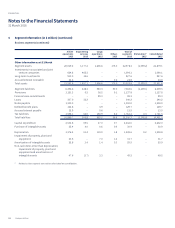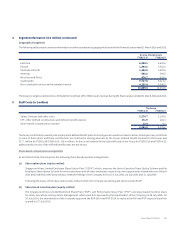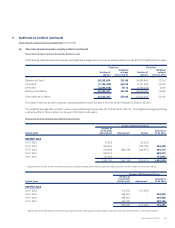Singapore Airlines 2016 Annual Report Download - page 135
Download and view the complete annual report
Please find page 135 of the 2016 Singapore Airlines annual report below. You can navigate through the pages in the report by either clicking on the pages listed below, or by using the keyword search tool below to find specific information within the annual report.2 Summary of Significant Accounting Policies (continued)
(ad) Aircra maintenance and overhaul costs
The Group recognises aircra maintenance and overhaul expenses (except heavy maintenance visits, engine overhaul and landing gear
overhaul expenses) on an incurred basis. For engine overhaul costs covered by power-by-hour third-party maintenance agreements, a
portion of the cost is expensed at a fixed rate per hour during the terms of the agreements. The remaining payments made are recorded
as an advance payment, to the extent that it is to be utilised through future maintenance activities. Upon completion of an overhaul,
these amounts are transferred to property, plant and equipment and depreciated over their useful lives.
(ae) Training and development costs
Training and development costs, including start-up programme costs, are charged to the profit and loss account in the financial year in
which they are incurred.
(af) Borrowing costs
Borrowing costs incurred to finance advance and progress payments for aircra are capitalised as part of advance and progress payments
until the aircra are commissioned for operation or the projects are completed. All other borrowing costs are recognised as finance charges
in the period in which they are incurred.
(ag) Claims and liquidated damages
Claims for liquidated damages, in relation to a loss of income, are recognised in the profit and loss account when a contractual entitlement
exists, the amount can be reliably measured and receipt is virtually certain. When the claims do not relate to a compensation for loss
of income, the amounts are taken to the statement of financial position as deferred credit, and included under deferred account, as a
reduction to the cost of the assets when the assets are capitalised and also for future reduction of operating lease expenses.
(ah) Derivative financial instruments and hedging
The Group uses derivative financial instruments such as forward currency contracts, foreign currency option contracts, cross currency
swap contracts, interest rate swap contracts, interest rate cap contracts, jet fuel option contracts, jet fuel, Brent and crack swap contracts
and jet fuel collar contracts to hedge its risks associated with foreign currency, interest rate and jet fuel price fluctuations. Such derivative
financial instruments are initially recognised at fair value on the date on which a derivative contract is entered into; any attributable
transaction costs are recognised in profit or loss as incurred. Subsequent to initial recognition, derivative financial instruments are re-
measured at their fair values.
Any gains or losses arising from changes in the fair value of derivatives that do not qualify for hedge accounting are taken directly to the
profit and loss account.
For the purpose of such hedging, the Group hedges USD exposure from aircra payments through a combination of USD deposits, forward
contracts and currency options. To create a USD-denominated asset/receivable in the statement of financial position to match against
the expected USD liability for capital expenditure, the Group hedges USD exposure from aircra payments up to 24 months in advance of
forecast aircra payments. On maturity, the exchange gains and losses of the assigned USD balance held are recognised in the carrying
value of the aircra.
At the inception of a hedge relationship, the Group formally designates and documents the hedge relationship to which the Group wishes
to apply hedge accounting and the risk management objective and strategy for undertaking the hedge. The documentation includes
identification of the hedged item or transaction, the hedging instrument, the nature of the risk being hedged and how the Group will assess
the hedging instrument’s eectiveness in osetting the exposure to changes in the hedged item’s (or transaction’s) cash flows attributable
to the hedged risk. Such hedges are expected to be highly eective in achieving osetting changes in cash flows, and are assessed on an
ongoing basis to determine that they have been highly eective throughout the financial reporting periods for which they are designated.
Annual Report FY2015/16 133


